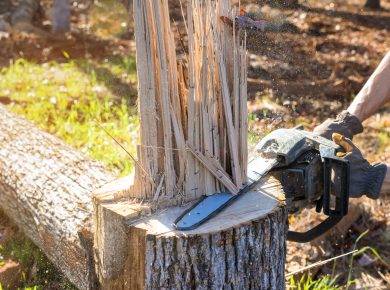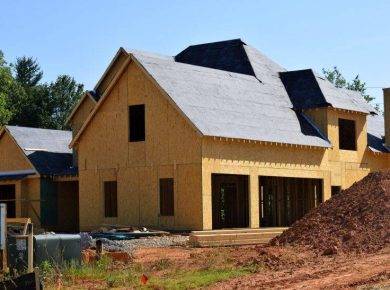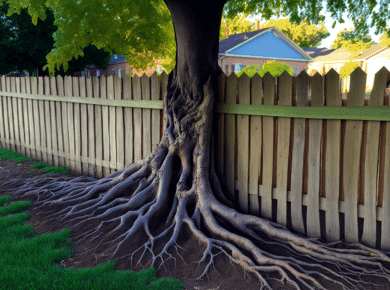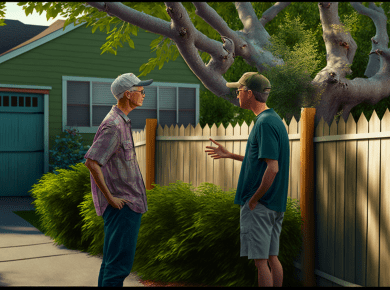Table of Contents
- A neighbor cut down my tree in Kentucky
- My neighbor cut my tree in Kentucky
- My tree branches overhang my property in Kentucky
- My neighbor damaged my tree on my property in Kentucky
- My neighbor’s tree roots or branches damaged my property in Kentucky
- Can my neighbor make me cut my tree?
- How can I get my neighbor to cut his dead tree in Kentucky?
- What happens if I cut my neighbor’s tree down in Kentucky?
- If your property was damaged click here to see if you might have a case.
A neighbor cut down my tree in Kentucky
If you live in Kentucky and your neighbor cut down your tree without permission, we can assist you in finding a lawyer in your area that practices in these types of cases.
First, it’s important to consider the following – the value of your tree, the tree’s location, and the legal implications that follow the incident. Understanding these three factors will help you pursue a legal claim against your neighbor.
To begin your legal process, document the removal of your tree. Take photographs of the area before and after the tree was cut down. Make sure to capture the whole area, and if possible, add dates to the photos. This will help you prove that the tree was yours and that your neighbor cut it down without your permission.
Next, determine the monetary value of the tree. This includes assessing the specific type of tree and its age, as well as the purpose of the tree (for example, aesthetic, fruit bearing, etc.). You can also research the approximate cost of similar trees and the market rate for similar trees.
Finally, review Kentucky’s laws regarding tree damages and removal. There are certain local ordinances and real property laws that regulate and limit the removal of trees. In Kentucky, the Kentucky Revised Statutes 339.200-339.367 regarding trespassing and property damage outlines how you can claim damages due to tree removal.
If you are still unsure of the legal implications of the incident, it is beneficial to contact a lawyer that practices in these kinds of cases. By connecting with a lawyer, you can review your evidence, discuss your legal options, and determine the most appropriate way to proceed with your case.
For more information on how to connect with a lawyer in your area that practices in cases involving tree removal, contact us today. We can provide you with the resources to pursue your legal claim and restore your property back to its original state.
My neighbor cut my tree in Kentucky
If your neighbor in Kentucky cuts your tree without permission, the first step is to file a complaint with the local county clerk’s office. The complaint should include the date of the incident, the name of the person responsible, and a description of the damage caused to the tree.
Next, you should take pictures of the damaged tree and any saw or cutting marks made by the neighbor on the tree. This evidence may be used in any legal proceedings and will help to back up your claim.
You should document any attempts you have made to contact your neighbor regarding the incident, such as emails or documents sent to them asking them to cease cutting your tree or to arrange a resolution with you.
If you decide to take legal action, you can contact a civil attorney in your area to represent you in court. Be sure to bring all the evidence, including photos, correspondence, and any other documents related to the incident, with you to the consultation.
You may also want to speak to law enforcement about the incident, as tree-cutting can be considered a trespassing violation in the state of Kentucky and may be punishable by fines and possible jail time.
Finally, you may wish to speak to a qualified arborist about the tree damage and how best to treat it. The arborist can give you advice regarding the best way to treat the cut tree and will likely be able to provide a written report documenting the damage caused and any suggestions for recovery.
My tree branches overhang my property in Kentucky
If you live in a rural area, it is likely that you could have a few trees that provide shade or act as a natural wind barrier. Unfortunately, their branches may also extend over your property in Kentucky and create potential damage or liability issues. Below is a guide to help you navigate this issue.
First, check your local laws to see if your trees are protected or regulated by local or state ordinances. In most cases, overhanging tree branches are not a violation as long as they do not touch or damage your property.
Second, check with your homeowner’s insurance provider to see if coverage is provided for any damages that may be caused by overhanging tree branches.
Third, if the tree belongs to you, you can prune or trim the branches yourself. This can be done with a pruning saw, pole pruners, or tree trimming shears. Be sure to only trim what is necessary, especially if the tree is a protected species.
Fourth, if the tree is your neighbor’s, you can contact them and request that they trim their tree branches. It is important that you respect their property rights, as it is illegal for you to climb and trim another person’s tree without their permission.
Finally, if the neighbor does not take action, seek legal help. You can contact a qualified attorney to file a civil suit against the neighbor if they refuse to trim the overhanging branches and they cause damage to your property.
These are the steps to take if you have a tree that is overhanging your property in Kentucky. Remember to check your local laws, have adequate insurance coverage, and take action if necessary to ensure that the tree is not harming your property.
My neighbor damaged my tree on my property in Kentucky
If your neighbor damaged a tree on your property in Kentucky, you may be able to take action to have your neighbor repair the damage done. Here are the steps you should take to address the issue:
- 1. Check with your local government about the ordinances in your area regarding trees. Some cities or counties may have laws that dictate how a neighbor must handle trees that belong to another property owner.
- 2. Gather evidence of the damage done to your tree. Take pictures of the tree and any other visible damage done to the tree.
- 3. Determine who is responsible for the damage to your tree. If the tree was damaged due to poor maintenance or negligence by the neighbor, they may be at fault and liable for the damage.
- 4. Speak to your neighbor about the damage to your tree. Explain what happened and provide the evidence to back up your claim. Ask your neighbor to make arrangements to have the tree repaired.
- 5. If your neighbor is unwilling to address the damage done to your tree, contact a local attorney with experience representing landowners in tree-related disputes. Your attorney may be able to help you take legal action to obtain compensation for the damages done to your tree.
- 6. If necessary, file a civil suit against your neighbor to further pursue the damages. Contact your local small claims court if you decide to do this.
Taking action when a neighbor has damaged your property is important and should not be taken lightly. Follow these steps and you will be able to ensure that your property rights are protected.
My neighbor’s tree roots or branches damaged my property in Kentucky
If you live in Kentucky and your neighbor’s tree roots or branches have caused damage to your property, the first step is to try and resolve the issue amicably. Reach out to your neighbor and let them know that their tree has caused damage to your property. Discuss potential solutions, such as having the tree removed, trimming the branches or roots to prevent further damage, or even offering to help with the cost of repair. Many people are willing to work cooperatively to find a mutually beneficial solution.
If you can’t reach an agreement, then you may have to take legal action. Document the damages and have them appraised. This will give you a better idea of the cost of repair or replacement. Document any conversations with your neighbor and keep evidence of their refusal to cooperate.
You may then have to speak to a lawyer to determine your legal rights and options. In Kentucky, a trespass claim may be settled through an injunction (an order from the court stating that your neighbor must stop the damage) or in civil court (for damages). In either case, you will want to speak with a lawyer familiar with Kentucky law to decide the best course of action.
Your neighbor is responsible for damage or losses caused by their tree. However, that doesn’t mean they’ll compensate you willingly. You may have to take legal action to get what’s rightfully yours. If you need help with a tree damage related issue in Kentucky, be sure to reach out to an experienced attorney.
Can my neighbor make me cut my tree?
In most cases, trees that are on private property are the responsibility of the owner of said property, typically the homeowner. That said, there are situations when a neighbor may be able to make you cut your tree. Here is a guide to what to do if your neighbor requests that you cut your tree:
- 1. Check local laws and regulations. Depending on where you live, there may be rules in place that limit your neighbor’s ability to force you to cut down your tree. Check with your municipality or town to determine what the laws are around trees and land use.
- 2. Request proof. Your neighbor may have grounds to ask you to cut your tree, such as if it is blocking light or damaging their property. However, a simple request is not enough. Ask for proof of the damage or evidence that the tree is a significant risk in order to consider cutting it.
- 3. Offer alternatives. Rather than cutting down the entire tree, there may be options that can mitigate the issue at hand. You can talk with your neighbor about potentially trimming the tree, removing any obstructing branches, or covering it with netting.
- 4. Treat mediation. If your conversations are not leading to a beneficial resolution, you may need to involve a mediator. A mediator can help assess the conflict and may be able to come to a mutually agreed solution that works for both sides.
- 5. Contact law enforcement if needed. In the case of serious disputes, the law may need to get involved. Contacting your local law enforcement and/or a lawyer may be necessary if the conflict escalates to a point where it is disrupting your ability to live in a safe, peaceful environment.
Ultimately, the decision of whether or not to cut a tree rests with the homeowner. However, depending on the case, your neighbor may be able to make you cut your tree.
It’s important to remember to always check local laws and regulations and to involve a mediator or law enforcement if necessary.
How can I get my neighbor to cut his dead tree in Kentucky?
- 1. Talk to your Neighbor – Before taking any other action, you should try to first talk to your neighbor directly and clearly explain why they need to cut down the dead tree. Make sure they understand the safety risks that the tree presents. Explain that a dead tree can create an eyesore and decrease the value of the entire neighborhood. If they need to be reminded that the decision is legally enforceable, let them know that cutting down dead trees is required by Kentucky law.
- 2. Report to Local Authorities – If talking to your neighbor does not work, you can file a complaint with local Kentucky authorities, such as the tree inspector or county forest service. The proper department will investigate the complaint and once it is confirmed that the tree is truly dead, they will issue an order for it to be removed.
- 3. File a Civil Lawsuit – If both of the steps above fail, you can take the issue to court with a civil lawsuit. You will need to prove that the tree is dangerous and that it poses a threat to people and neighboring property. This can be done by presenting photos, on-site testimony and other evidence. If you win the case, the court can rule that your neighbor must remove the dead tree.
- 4. Hire a Tree Service Company – If your neighbor continues to ignore their legal obligation to cut their dead tree, you could hire a reputable tree service company to take care of the problem. These companies can safely remove the tree and dispose of it. Most will charge a fee but you can often negotiate premiums that are lower than the fees your neighbor would have to pay if taken to court.
What happens if I cut my neighbor’s tree down in Kentucky?
If you cut down your neighbor’s tree without permission in Kentucky, you could be liable for damages. This is because the tree is considered your neighbor’s property. Depending on the size and value of the tree, the penalty can be substantial.
The first step is to try and settle the matter outside of court. You should discuss the matter with your neighbor and try to come to an agreement about how to make up for the tree, such as reimbursing the cost of a replacement tree and paying for the labor or other associated costs. If this cannot be achieved, then the matter may have to be settled in court, which could get expensive depending on the size of the claim.
In court, the judge can award a payment of up to three times the cost of the tree, depending on the value of the tree and the circumstances surrounding the case. The court can also make you pay the cost of removing the tree, such as a tree service, mulch, and fertilizer, in addition to a fine of up to $200. The judge may also enforce an injunction, which means you must plant a new tree to replace the one that was cut down.
Regardless of the outcome in court, it’s important to understand that it is illegal to remove trees from someone else’s property without their permission. If this does happen, it’s best to resolve the issue amicably with your neighbor. Ignoring the situation may result in legal action, which can be expensive and time-consuming.



